UML Layout
Developing a Layout Algorithm for UML diagrams
Intro
Presented to the Melbourne Patterns Group, Wednesday 6th April 2011 6:30 PM
The Problem: Untangling UML Diagrams
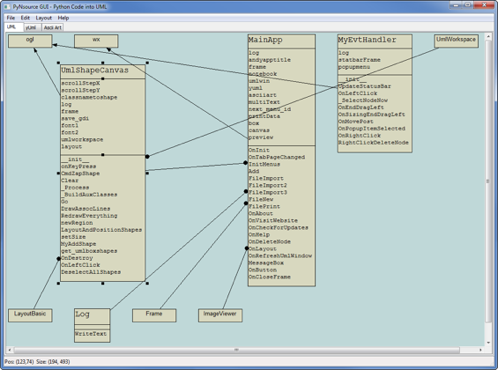
Terms
- Nodes – these are the shapes/rectangles
- Edges – these are the lines connecting the shapes
Background
- My UML tool is written in Python
- Existing layout libraries for e.g. python PyGraphviz has no windows port so I wrote my own
- Layout is reasonably hard to implement – academic papers are very complex and deal in a lot of math
- DIRTY SECRET OF ACADEMIA - Most Layout algorithms only deal with ‘points’ and don’t take into account real width and height
Thus for any real world use (unless dealing with network and particle visualisation where each node is the same size/shape), it seemed to me that one needs to run an overlap removal algorithm after the layout to remove shape overlaps.
Overlap removal algorithm needs to minimise shape movement in order to respect the layout results
What I developed
- I used a ‘spring layout’ adapted from java and javascript
- I developed my own overlap removal algorithm
- Developed a GUI sandbox test app for development
Overlap Removal - Before and After

before

after applying layout
Unit Testing
Extensive unit tests were created to keep on top of the layout algorithm results. A word document containing annotated screenshots for each test helped me enormously.

an overlap removal use case which became a unit test
Layout / persistence format was created for creating layout scenarios
{'type':'node', 'id':'D25', 'x':6, 'y':7, 'width':159, 'height':106}
{'type':'node', 'id':'D13', 'x':6, 'y':119, 'width':119, 'height':73}
{'type':'node', 'id':'m1', 'x':170, 'y':9, 'width':139, 'height':92}
Unit Testing Brittleness Avoided
Loose tests using (e.g. I created a function called ensureYorder() etc) were created so that the tests were not too brittle. Slight variations in position are ignored.
View this unit test file at the Pynsource GitHub repository tests/test_overlaps1.py. Here is an example unit test:
def _LoadScenario3(self):
self.g.LoadGraphFromStrings(TEST_GRAPH3)
def test3_5InsertedVerticallyTwoPushedDown(self):
self._LoadScenario3()
# move m1 to the left
node = self.g.FindNodeById("m1")
node.left, node.top = (6, 4)
d97 = self.g.FindNodeById("D97")
oldD97pos = (d97.left, d97.top)
# assert m1 has been inserted vertically - two pushed down
were_all_overlaps_removed = self.overlap_remover.RemoveOverlaps()
self.assertTrue(were_all_overlaps_removed)
self.assertEqual(2, self.overlap_remover.GetStats()["total_overlaps_found"])
self.assertTrue(self._ensureYorder("m1", "D25", "D13"))
self.assertTrue(self._ensureXorder("m1", "D97", "D98"))
self.assertTrue(self._ensureXorder("D25", "D97", "D98"))
self.assertTrue(self._ensureXorder("D13", "D97", "D98"))
self.assertEqual(oldD97pos, (d97.left, d97.top)) # ensure D97 hasn't been pushed
Running the tests:
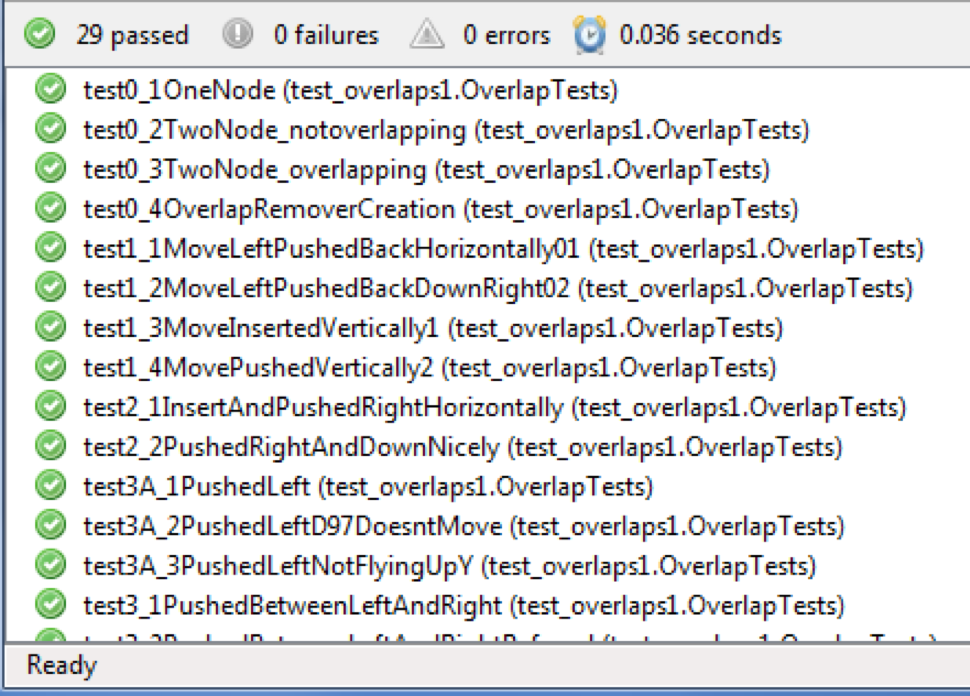
An example test run
Having a huge bank of unit tests helped in refactoring, too. Imagine testing all the necessary scenarios by hand!
The final Results were pretty good!

A UML diagram after overlap removal
Design Patterns Used
Memento
- Memento was used to remember graph layout positions and then compare mementos to see if anything had ‘changed’ and thus drop out of the Spring layout algorithm early
- Memento was used to save/restore layouts in my test GUI – assigned to keys 0..9
Blackboard
Blackboard pattern used to run layout several times and figure out which was the best, cleanest result using multiple criteria. Each run is a ‘snapshot’
Snapshot 1 [6] LL 0 NN pre rm overlaps 5 LN 0 scale 1.6 bounds 23 (500, 473) <---
Snapshot 2 [4] LL 0 NN pre rm overlaps 5 LN 1 scale 1.4 bounds 30 (570, 537)
Snapshot 3 [5] LL 0 NN pre rm overlaps 6 LN 2 scale 2.0 bounds 17 (444, 393)
Snapshot 4 [2] LL 0 NN pre rm overlaps 4 LN 2 scale 1.4 bounds 34 (648, 537)
Snapshot 5 [3] LL 0 NN pre rm overlaps 5 LN 4 scale 2.0 bounds 21 (427, 508)
Snapshot 6 [1] LL 0 NN pre rm overlaps 10 LN 5 scale 2.0 bounds 18 (485, 379)
Python goodness helped in this ‘AI’ smartness
def sortfunc(d):
# this does the thinking!
return (d['LL'], d['LN'], d['bounds_area_simple'], -d['scale'], d['NN_pre_OR'])
Future
- “Line over node” overlap was abandoned as it started to get really complex with a lot of trigonometry and perhaps this area needs a more academic approach
- Non straight lines and line routing is probably the better direction
- Adding an understanding of UML semantics is another direction to research, so that e.g. base classes are above derived classes etc.
Overlap Removal Server
In 2020 I needed to expose the overlap removal code as an API for javascript to use.
Here is that small research sub-project https://github.com/abulka/pynsource/tree/master/Research/overlap_removal_server
Resources
Code and Links
- Overlap removal code is Python, open source
- Part of my python UML tool PyNSource: Reverse engineer python source code into UML - display UML as Ascii art or PlantUML diagrams in a proper diagramming visual workspace.
Slides on Scribd
UML Graph Layout - Andy Talk - March 2011
Slides as HTML
- The problem of laying out UML
- Spring Layout
- Mapping layout to Real World
- OGL
- MVC
- Overlap Removal
- Unit tests and unit test diagrams
- Memento Design Pattern
- Blackboard Design Pattern & Injecting sorting function
- Future..
Slides as Pdf download
Images
Sample Images

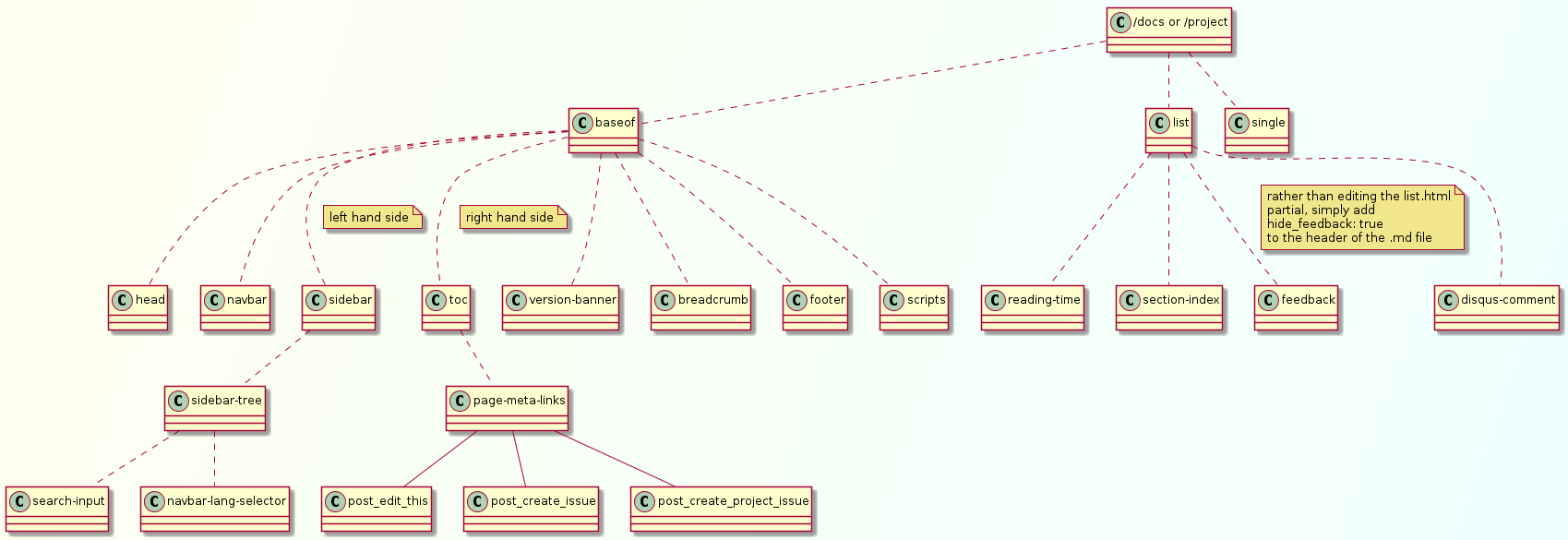
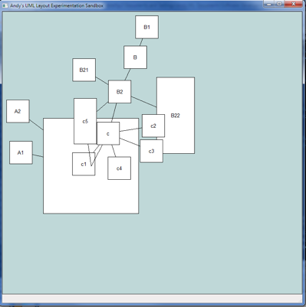
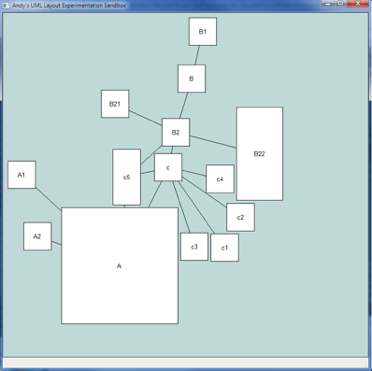

before

after applying layout